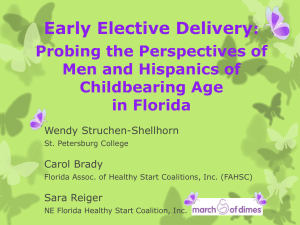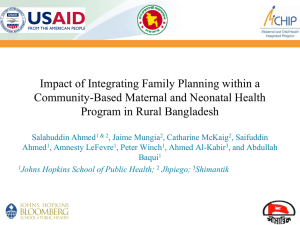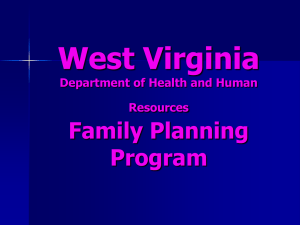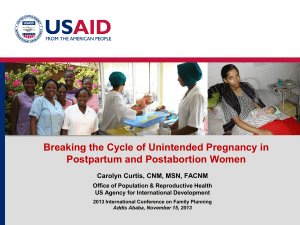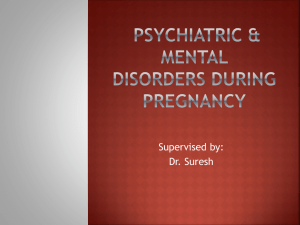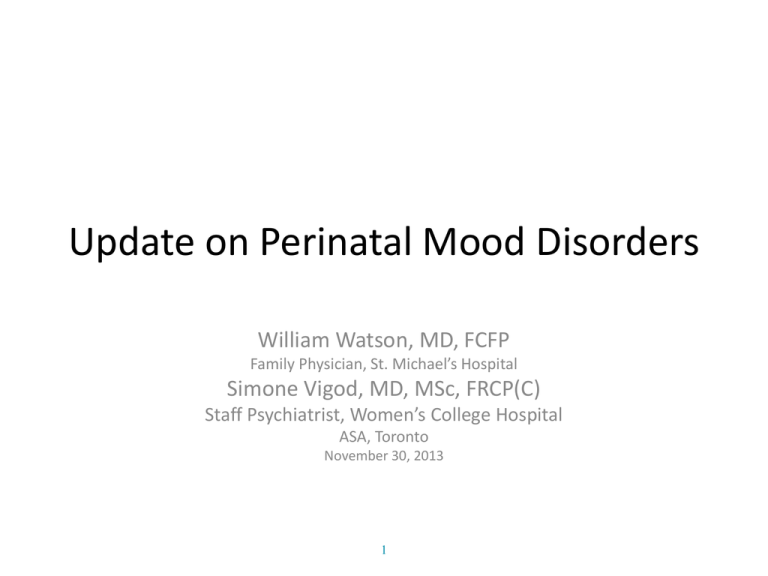
Update on Perinatal Mood Disorders
William Watson, MD, FCFP
Family Physician, St. Michael’s Hospital
Simone Vigod, MD, MSc, FRCP(C)
Staff Psychiatrist, Women’s College Hospital
ASA, Toronto
November 30, 2013
1
Objectives
• To learn about updated risk factors for
perinatal mood disorders in the family
practice context
• To learn about prevention and treatment of
depressive and bipolar disorders in
pregnancy and the postpartum period
2
Faculty/Presenter Disclosure
• Faculty: Dr. Bill Watson and Dr. Simone Vigod
• Program: 51st Annual Scientific Assembly
• Relationships with commercial interests:
NIL
Disclosure of Commercial
Support
Dr. Watson has received some financial support from the OCFP in
the form of an honorarium, and has no financial disclosures or
conflicts of interest related to this presentation
Dr. Vigod receives salary support from the Ontario Mental Health
Foundation (New Investigator Fellowship), Women’s College
Hospital and Research Institute (Shirley-Brown Clinician
Scientist), and the Dept. of Psychiatry, University of Toronto
• She receives operating funds from the Canadian Institutes of
Health Research (CIHR), the Schizophrenia Society of Ontario
and the Ontario Ministry of Health and Long Term Care
(MOHLTC)
• She has no financial disclosures or conflicts of interest to
declare relevant to this presentation.
Mitigating Potential Bias
• There is no source of potential bias and no support or
funding from pharmaceutical companies
Case 1: Sarah
• 29-year-old, married, real estate agent
• Had a depressive episode 2 years ago where
she lost interest in work and quit her job,
which negatively affected her interpersonal
relationships as well
• No evidence of bipolarity, no history of
psychosis or safety issues
• You treated her successfully with sertraline,
and she has reached remission
• She and her new husband plan to try to
become pregnant imminently
• She asks you if this is the right time to
discontinue her antidepressant
6
Case 2: Maria, aged 22
• Maria, G1P1, five-day-old baby boy - checkup.
– Normal pregnancy and delivery, baby is healthy but has lost 100 g
since birth. Maria is breastfeeding and having difficulty with the baby’s
latch, and she thinks she doesn’t produce enough milk. She looks very
tired and on the verge of tears.
– Maria says she hasn't been out of the house since the baby was born,
and that she has been crying frequently. She worries about the house
being a mess when visitors arrive.
– John, the baby’s father, accompanies them. John is bewildered by her
tears and asks you if her tearfulness is normal. He is concerned about
how she is feeling and quietly asks if she is depressed.
• What is the next step?
Case 3-Mrs. C
• A 35 year old teacher
• Brought to the office by her
husband of 10 years
• He has noticed that since the
birth of their one month old
daughter, Mrs. C. has not been
her normal self-he is worried
• Mrs. C starts to cry after you ask
her about the baby
– She feels overwhelmed, a bad
mother, and especially guilty
about having had a baby
– Most of the time she is irritable
and anxious
• Personal hx of abusive
(psychological) mother
• You note she is tearful,
frustrated, poor motherinfant interaction
Why know about perinatal mood
disorders?
• An important public health issue
– Risk of a Major Depressive Episode is up to 10% in
pregnancy, 15% postpartum (higher than agematched point prevalence in the non-pregnant
population)
– Risk of bipolar disorder relapse is high in
pregnancy and very high in the postpartum period
Why know about perinatal mood
disorders?
• Potential Impact of untreated mood disorders on
mother, baby and family can be profound:
– Pregnancy: spontaneous abortion, poor prenatal care,
substance use, poor fetal growth, preterm labour, suicide
– Postpartum: poor attachment/parenting, delayed infant
motor, language and cognitive development, child
behaviour problems, suicide/infanticide
Still face experiment
• www.youtube.com/watch?v=apzXGEbZht0
Spectrum of Illness
• Entire range of psychiatric disorders occur
during the perinatal period
– Perinatal period generally defined from onset of
pregnancy until ~ 1 year postpartum
• NOTE: DSM-5 defines perinatal onset for mood
disorders as being onset during pregnancy or within 4
weeks postpartum
– Management often begins at pre-conception
counseling for women with a personal history of
mental health problems
Management of Perinatal Mood Disorders
• Prevention
– Decision-making related to relapse risk, follow-up
plans, psycho-education re: need for sleep and good
social support
• Treatment
– Safety Assessment
– Risk-benefit analysis: safety of treatment during
pregnancy/lactation vs. risks of untreated illness
– Options: Psychotherapy, Psychotropic Medication, ECT,
Novel somatic treatments
Context in Family Practice
•
•
•
•
Hospital/office setting
Well baby, well family exam
Other family members/relationships
Resources
Screening tools
National Institutes for Clinical
Excellence (NICE)
•
During the past month, have you often
been bothered by feeling down,
depressed or hopeless?
•
During the past month, have you often
been bothered by having little interest or
pleasure in doing things?
If the woman answers 'Yes' to both questions
a further question should be asked:
•
Is this something you feel you need or
want help with?
Edinburgh Postnatal Deperssion
Scale (EPDS)
In the past seven days:
•
I have been able to laugh and see the funny side of things
•
I have looked forward with enjoyment to things
•
I have blamed myself unnecessarily when things went wrong
•
I have been anxious or worried for no good reason
•
I have felt scared or panicky for no very good reason
•
Things have been getting on top of me
•
I have been so unhappy that I have had difficulty sleeping
•
I have felt sad or miserable
•
I have been so unhappy that I have been crying
•
The thought of harming myself has occurred to me
Scored 0-30. Scores > 13 associated with
10x likelihood that patient has major
depression
PHQ 2 and 9 may detect PPD at well
baby visits
(Cochrane 2013)
• 82% sensitivity, 84% specificity
• Compares favorably with EPDS
• May be effective in screening for PPD
• PHQ-2=During the past 2 weeks, how often have you been bothered by:
– Little interest or pleasure in doing things (0-3)
– Feeling down, depressed or hopeless (0-3)
– If score > 3, use PHQ-9
Why do postpartum mental health
problems go undetected?
•
•
•
•
•
Normal vs abnormal?
Guilt around depression
Little preparation for postpartum
Lack of recognition by peers and professionals
Some women hide depression very well
Mood Disorders in Pregnancy
Mood Disorders in Pregnancy
• Not necessarily a high risk time for new onset
– Although, in general, the 3rd and 4th decades of life are high risk for onset
of mood disorders in women
– Unplanned pregnancy, marital or financial instability may pose risk
• Relapse rates of existing disorders are high
– Risk Factors for Relapse (Viguera 2011)
• Younger age at onset
• Previous postpartum episodes
• Fewer years of illness
• Bipolar disorder
• Fewer children, and
• Not being married
Relapse of Major Depression when
Antidepressants are Discontinued
1.0
Maintained Rx (n=82)
Discontinued Rx
(n=65)
0.9
0.8
Proportion of
Pregnant Women
Remaining
Euthymic
0.7
26%
0.6
0.5
0.4
0.3
68%
HR: 5.0 (2.8-9.1)
0.2
0.1
0.0
0
4
8
12
16
20
Weeks of Gestation
24
28
32
36
40
Cohen et al. JAMA 2006;295(5):499-507.
Unipolar Depression in Pregnancy
• But….
• In the Cohen et al. study, the overall relapse rate was
43% and ~ 75% of the women had 3+ prior episodes
of depression
Unipolar Depression in Pregnancy
• In a sample that included women who were
less severely ill Yonkers et al., 2011
– Relapse rate = 16%
– Women with 4 or more episodes before
pregnancy were at highest risk of depression in
pregnancy
– Discontinuation of antidepressants in pregnancy
did not have a strong effect on the development
of a major depressive episode
22
Unipolar depression in pregnancy
• Take Home Points:
1. History of recurrent depression increases risk of
depression in pregnancy
2. Severity may be an effect modifier with respect to
medication discontinuation:
•
•
In women with severe and/or recurrent depression,
discontinuation of medication represents risk of relapse
In women with less severe histories of depression, the impact of
medication discontinuation may not be as dramatic
23
Psychotropics
• Pregnancy
– 3 theoretical risks of meds
• Teratogenesis (1st trimester exposure usually)
• Neonatal toxicity or withdrawal (3rd trimester)
• Developmental effects with latent childhood manifestations
• Lactation
– Passage into breast milk and theroretical risk of toxicity in
the infant
Risk/Benefit Primer
Maternal Depression
SSRI/SNRI Medication
(likely class effect)
Evidence for marginally increased risk of:
Negative effects of depression on daily
function, sense of well being, experience of
pregnancy
Spontaneous abortions (TM1)
Preterm birth (no high risk of < 36 weeks)
Lower birthweight (only by 200-300g)
Factors associated with depression that may
impact fetal outcomes: reduced antenatal care
attendance, smoking, substance and alcohol use
Lower APGAR scores
Cardiovascular malformations (TM1)
Increased risk of postpartum depression
Possible negative effects on child in infancy
and early childhood
Yonkers, K. A., Wisner, K. L., Stewart, D. E., Oberlander, T. F.,
Dell, D. L., Stotland, N., … Lockwood, C. (2009). The
management of depression during pregnancy: a report from
the American Psychiatric Association and the American
College of Obstetricians and Gynecologists. American
Psychiatric Association, 114, 703-713.
25
•
ARI 5/1000 to ~ 8/1000
•
Likely class effect despite early focus
on paroxetine
Neonatal persistent pulmonary hypertension
•
AOR~2 in cohort studies (6 in casecontrol) for TM 2 exposure
•
ARI 1.2/1000 to ~3/1000
Neonatal Adaptation Syndrome
•
Set of neurobehavioral signs occurring ~ 30% of SSRI/SNRI exposed full term
babies vs. 10% of non exposed babies
•
Possible symptoms
•
•
–
Usually mild: Insomnia or somnolence ; Agitation , tremors, jitteriness, shivering and/ or altered tone;
Restlessness, irritability & constant crying; poor feeding, vomiting/diarrhea
–
Severe syndrome that consists of seizures, dehydration, excessive weight loss, hyperpyrexia (poor
temperature control), or intubation (due to tachypnea/respiratory distress) is rare in term infants
(1/313 quantifiable cases)*
Duration Usually short lived
–
Median duration of 3 days, and 75 % complete resolution by 5 days (max 4 weeks)’
–
Premature babies are more vulnerable to NAS, and are more likely to develop signs, which may be
more severe.
–
Weak evidence that severity of symptoms may be dose related
Management supportive
Neonatal Signs After Late In Utero
Exposure to Serotonin Reuptake
Inhibitors. Moses-Kolko et al.JAMA 2005;
293; 2372-2383
26
Psychotherapy in PMD
• In general, psychosocial and psychological
treatments without meds are recommended as firstline treatment of antenatal depression
• Evidence that individual psychotherapy may be
useful in women with mild-moderate symptoms (IPT
and CBT have best evidence)
• Takes time… while fetus may be exposed to
effects of illness
• Need access and resources!
Antidepressant Medication
• SSRI or SNRI is first line treatment for moderate
to severe depression
– No evidence for preferred treatments based on effectiveness or safety,
but most safety data on older SSRI/SNRIs
– Usually no need to change dose for pharmacokinetic reasons
– Sertraline and Paroxetine usually undetectable in serum of breastfed
infants, Others < 10% passage but no adverse events reported
• < 20% of women accept treatment
– Misinformation about risks (untreated illness and treatment)
– Stigma/Pressure from family, friends, media and providers
28
Other antidepressants
• Other first-line antidepressants
– E.g. Bupoprion, Mirtazapine
– Much less data than SSRI/SNRIs, but nature and
magnitude of risks likely similar
• Tricyclic Antidepressants
– No clear concerns about teratogenicity, but withdrawal syndromes
occur in neonates
– Blood levels can be monitored through pregnancy and will likely
require dosage increases as pregnancy progresses, although clinical
assessment is a better marker of response than blood levels
29
Benzodiazepines
• May be required for concurrent management of
anxiety and/or sleep in severe cases
• Contradictory data on increased risk of cleft
palate/lip with 1st trimester exposure
– Best to avoid in 1st trimester
• Theoretical risk of neonatal withdrawal and of
toxicity in breast-feeding
– Use shorter half-live drugs – lorazepam, clonazepam
– Monitor infants
30
ECT
• Efficacious, but has side effects and requires general
anesthetic
• Risk is minimal but not non-existent
– Case reports suggest potential associations with adverse
cardiovascular events and some adverse neonatal outcomes
• Use in pregnancy usually limited to: severe treatmentresistant depression, acute suicidality, psychotic
depression, or severe dehydration/malnutrition
secondary to a depressive syndrome
31
Alternative Treatments
• If there is benefit, then it is likely for women with
mild depressive illness
– Limited support for some non-pharmacologic
alternatives to psychotherapy: Dietary calcium,
Exercise, Massage therapy, Bright light therapy
• Early enthusiasm for omega-3 fatty acids
– Most randomized clinical trials to date have failed to
show that the active treatment differs from placebo
32
Alternative Treatments
• Repetitive Transcranial Magnetic Stimulation (rTMS)
– Investigated widely for severe or treatment-resistant depression
– Magnetic fields have been associated with increased risk of
miscarriage --- there is a theoretical risk to administering transcranial
magnetic stimulation in pregnant women
– However, it is under study in pregnant populations
• There is a clear need for safe and rapidly effective treatments
for women with depression in pregnancy
33
Bipolar disorder in Pregnancy
• Relapse risk high
– 25-75% depending on population studied
– Up to ¾ episodes depressed/mixed and ½ in 1st trimester
(for women euthymic at conception) (Viguera 2007)
… and related to medication discontinuation
• Recurrence risk two-fold greater in those who discontinued medication
with median time to recurrence 4x shorter
• Median time to recurrence 11 times shorter if meds discontinued abruptly
vs. gradually
Risks of Continuing medication
Weigh risk/impact of
relapse
vs.
Potential risks of
medication use
35
Mood Stabilizers
• Lithium
– Only slightly increased risk of cardiac defects (e.g. ebstein’s
anomaly) when used in pregnancy
– Need to attend to ECF changes in pregnancy AND massive
ECF contraction at delivery
• Some recommend discontinuation of Lithium with onset of labour
and restart day 2 postpartum
– Passes into breast milk and toxicity can be substantial
therefore CLOSE monitoring if used
Mood Stabilizers
• Valproate
– Teratogenic (neural tube defects - NTD)
– Recent reports of developmental delay in breastfed infants
• Lamotrigine
– Risk of NTD
– Passes into breast milk (up to 30% of maternal levels)
theoretical risk of rash
Anti-psychotics
• Pregnancy:
– Haloperidol best studied – not thought teratogenic
– Main Issue with newer anti-psychotics is potential for
weight gain and gestational diabetes
– FDA warning re: Extra-pyramidal symptoms (EPS) in
newborns
• Minimal data in breast-feeding
– Clozapine and Olanzapine not recommended due to
risk of blood abnormalities and EPS respectively
Summary re: management in
pregnancy
• There are substantial risks to untreated mood
disorders in the pregnancy
• Choice of treatment involves a risk-benefit
analysis unique to each patient
– Do not underestimate effect of decisional conflict,
stigma and lack of support for women faced with
these decisions about medication use
Postpartum mood disorders
Postpartum Mood Disorders
• Risk appears to be substantially higher than in pregnancy
both for new onset and recurrent mood disorders
• Formulation?
– Biological factors such as genetic predisposition to
rapid change in hormones at delivery…. May also have
medical issues (anemia, thyroid)
– Psychological factors: psychodynamic considerations
(e.g. history of trauma, separation-individuation,
issues with dependency), personality and coping style
– Social factors: social support, life stressors (e.g. health
of baby, financial, intimate partner violence)
From: Episodes of Mood Disorders in 2,252 Pregnancies and Postpartum Periods
American Journal of Psychiatry 2011; 168:1179-1185 doi: 10.1176/appi.ajp.2011.11010148
Figure Legend:
Episode Occurrence Rates of Major Affective Episodes During Pregnancy and During the Postpartum Period in 1,162 Women With
Bipolar I, Bipolar II, or Major Depressive Disordera
Date of download:
2/22/2012
Copyright © American Psychiatric Association.
All rights reserved.
Postpartum Mood Symptom Spectrum
• Baby Blues: up to 75%, within days, resolves within first
month without treatment, likely hormone-related
• Postpartum Depression (PPD): major depressive episode
(MDD) with onset in the 1st postpartum year (requires
treatment)
• Postpartum Psychosis: psychotic episode, 90% occurring
within first 3 months postpartum, likely a bipolar disorder
presentation (*Psychiatric Emergency*)
Post-Partum Depression
Onset: DSM 5 indicates within 4 weeks of delivery, genetics
work suggests onset 6-8 weeks and clinically, even later
onset observed
Risk Factors: Untreated depression/anxiety in pregnancy,
poor sleep , poor social support, stressful life events
Symptoms: same as major depressive episode
• 50% with anxiety – panic, obsessive ruminations
• Themes of incompetence, obsessional harm (differentiate from
psychosis)
Bipolar Disorder Postpartum
• Relapse 30-50% - acute and severe
– mostly depressive
• Risk Factors (other than medication discontinuation):
– Younger age, primiparity, sleep/biological rhythm disturbance
– Psychosocial risk factors play less of a role
• Increased risk of postpartum psychosis
– 90% within 4 weeks of delivery
– Marked by confusion, thought disorder
– Small but serious risk of suicide/infanticide
Back to Sarah
• Is this right time to discontinue her antidepressant?
– Consider severity/recurrence of depressive illness (attn: to prior
pregnancies/postpartum periods and premenstrual symptoms)
– Consider how quickly/effectively she responds to nonpharmacological and pharmacological treatment
– Consider other risk factors for poor pregnancy outcomes or relapse
(e.g. medical and psychiatric comorbidity, psychosocial)
– Consider gestational age of patient (i.e. planning vs. 1st trimester)
– Consider her personal preferences
46
Possible Plans: Sarah
Discontinue
Continue
– Monitor for recurrence of illness
– If illness recurs in pregnancy:
consider non-pharmacologic and
pharmacologic treatment
strategies and potentially restart
medication
– Plan for prevention of
postpartum depression
– No clear evidence for
prophylactic re-start of
medication postpartum in
euthymic women
– Pharmacokinetic changes in
pregnancy and at delivery
• Absorption (watch emesis)
• Distribution (increased ECF during
pregnancy – contracts rapidly at
delivery)
• Increased hepatic metabolism
– Echocardiogram screening
– Continue to monitor and plan for
prevention of PPD
– Counsel around potential risks of
antidepressant use and NAS
– Counsel patient around
antidepressants in lactation
47
Other considerations
1. If she elects to continue:
– Would you recommend changing to a different
antidepressant?
– Should you reduce her dose or discontinue in 3rd
trimester to avoid NAS?
2. What if she had presented already
pregnant… at 14 weeks gestation?
48
Case 2: Maria, aged 22
• Maria, G1P1, five-day-old baby boy - checkup.
– Normal pregnancy and delivery, baby is healthy but has lost 100 g
since birth. Maria is breastfeeding and having difficulty with the baby’s
latch, and she thinks she doesn’t produce enough milk. She looks very
tired and on the verge of tears.
– Maria says she hasn't been out of the house since the baby was born,
and that she has been crying frequently. She worries about the house
being a mess when visitors arrive.
– John, the baby’s father, accompanies them. John is bewildered by her
tears and asks you if her tearfulness is normal. He is concerned about
how she is feeling and quietly asks if she is depressed.
• What is the next step?
Case 2-Commentary
•
•
•
•
Depression vs Blues
PHQ 2 = 2
Ref to Lactation consultant
-Early follow-up for mom and baby
Case 3-Mrs. C
• A 35 year old teacher
• Brought to the office by her
husband of 10 years
• He has noticed that since the
birth of their one month old
daughter, Mrs. C. has not been
her normal self-he is worried
• Mrs. C starts to cry after you ask
her about the baby
– She feels overwhelmed, a bad
mother, and especially guilty
about having had a baby, not
sleeping
– Most of the time she is irritable
and anxious
• Personal hx of abusive
(psychological) mother
• You note she is tearful,
frustrated, poor motherinfant interaction
Case 3 -commentary
-PHQ2= 6, EPDS=20
-Mrs. C likely has postpartum mood disorder
-important to discuss findings with her and her
husband
-make urgent referral to psych
-consider using SSRI/SNRI +/- hypnotic
-referral to support group
-early follow up
Postpartum Depression Management
• Lifestyle and Social Support: Ensure adequate sleep,
engage social supports
• Psychotherapy: For mild and moderate depression,
evidence for interpersonal psychotherapy and cognitive
behaviour therapy (group and individual)
• Medication: Same principles as non-postpartum
– all antidepressant medications pass into breastmilk at <
10% of maternal dose;
– use of benzodiazepines is NOT an absolute
contraindication for breastfeeding with healthy full-term
infant
Bipolar Disorder Management
1. Prevention: social support, sleep protection, some advise
longer stay with rooming out of baby for high risk mothers but
evidence limited for this strategy
2. Safety Assessment: mother, baby (+/- other kids)
3. Treatment: based on nature and severity of illness
– Psychotherapy: Strongest evidence for Interpersonal
Therapy (IPT) where focus is on role transition to
parenthood and improving communication abilities and
social support
– Psychotropic medication: as indicated, consider passage
into breastmilk and risk of toxicity
– Somatic Therapies
Management
• When to refer (examples)?
– Diagnostic clarity
– Need for specialized psychotherapy
– Failure to respond to first-line antidepressant
medication treatment
– Postpartum psychosis - a psychiatric emergency
• Do not leave mother unsupervised
• Send to emergency department (hospital) for
assessment and treatment –Form 1
Useful References
1.
2.
3.
4.
5.
6.
Hendrick, V and Gitlin, M. Psychotropic Drugs and Women: Fast Facts, Norton and
Company, NY, 2004.
Payne JL, Palmer JT, Joffe H: A reproductive subtype of depression: Conceptualizing models
and moving toward etiology. Harv Rev Psychiatry 17: 72-86,2009
Yonkers KA, Wisner KL, Stewart DE, Oberlander TF, Dell DL, Stotland N, Ramin S, Chaudron
L, Lockwood C. The management of depression during pregnancy: A report from the
American Psychiatric Association and the American College of Obstetricians and
Gynecologists. Gen Hosp Psychiatry Sep-Oct;31(5):403-13, 2009
Yonkers KA, Vigod S, Ross LE. Diagnosis, Pathophysiology and management of mood
disorders in pregnant and postpartum women. Obstet Gynecol. 2011 Apr;117(4):961-77.
Review.
Cohen LS: Treatment of bipolar disorder during pregnancy. J Clin Psychiatry 68 Suppl 9: 49,2007
Einarson A, Boskovic R: Use and safety of antipsychotic drugs during pregnancy. J Psychiatr
Pract 15: 183-192,2009
56
Questions/Discussion
57


